
The blood-vein is a moth of the family Geometridae. The species was first described by Anton Schmidt in 1931.

Ceratodalia is a genus of moths in the family Geometridae, containing only one species, Ceratodalia gueneata, which is found in western North America, ranging from British Columbia and Alberta to Colorado and California.

Eulithis testata, the chevron, is a moth of the family Geometridae. The species was first described by Carl Linnaeus in 1761. It is found in both the Palearctic and the Nearctic realms. In Eurasia it ranges from Great Britain and Scandinavia, south to the Alps, east through Russia and the Russian Far East to Japan. In North America, it is found from Newfoundland to Vancouver Island and Alaska, south in the east to about New Jersey and in the west to Colorado.

Digrammia irrorata is a moth of the family Geometridae first described by Alpheus Spring Packard in 1876. It is found in the western United States and south-western Canada.

Iridopsis ephyraria, the pale-winged gray, is a moth of the family Geometridae. It is found in the United States and southern Canada east of the Rocky Mountains, from New Brunswick to Florida, west to Texas and north to Alberta.

Macaria aemulataria, the common angle moth, is a moth in the family Geometridae. It is found from Nova Scotia to Florida, west to Texas, north to Oregon and Alberta.
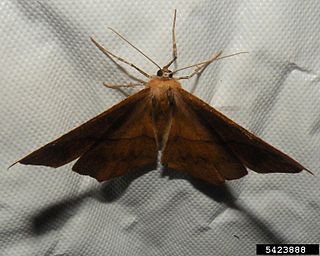
Prochoerodes lineola, the large maple spanworm, is a moth of the family Geometridae. It is found from Nova Scotia to Florida, west to Texas and north to Alberta.
Scopula fuscata is a moth of the family Geometridae. It was described by George Duryea Hulst in 1887. It is found in North America from south-western Saskatchewan west to British Columbia and south to California and Arizona. The habitat consists of montane areas, including foothills.

Xanthorhoe labradorensis, the Labrador carpet moth, is a moth of the family Geometridae. It is found across Canada from Newfoundland and Labrador to British Columbia and Alaska, north to Yukon and the Northwest Territories, south in the east to Louisiana and Mississippi. The habitat consists of open wooded areas and edges.
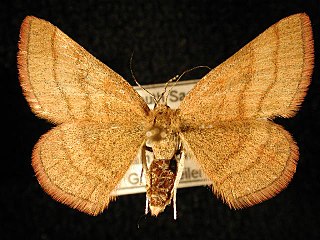
Scopula sentinaria is a moth of the family Geometridae. It is found from Alaska to Labrador, south in the prairies to southern Manitoba, Saskatchewan, Alberta and British Columbia. In the mountains it ranges south to Colorado. The species is also found in northern Russia and the Sayan Mountains. The habitat consists of dry shrubby clearings and edges.
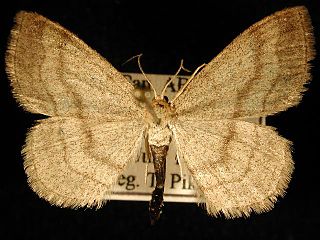
Scopula siccata is a moth of the family Geometridae. It is found from northern Colorado north through Wyoming, western Montana and Idaho to southern British Columbia and south-western Alberta. The habitat consists of dry slopes in mountainous areas.
Scopula sideraria is a moth of the family Geometridae. It is found in western North America, from southern British Columbia to San Diego County, California.
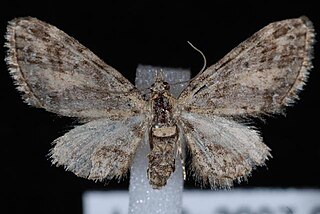
Eupithecia maestosa is a moth in the family Geometridae. It is found from extreme western Alberta west to Vancouver Island, north to northern British Columbia and south to Texas and California. The habitat consists of wooded and shrubby areas.

Eupithecia nimbicolor is a moth in the family Geometridae first described by George Duryea Hulst in 1896. It is found in North America from eastern Newfoundland and Labrador to western British Columbia and from Alaska to Arizona.

Eupithecia niveifascia is a moth in the family Geometridae first described by George Duryea Hulst in 1898. It is found in North America from south-western Alberta west to Vancouver Island, north to northern coastal British Columbia and south to New Mexico.
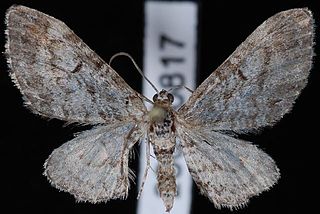
Eupithecia graefi, or Graef's pug, is a moth in the family Geometridae. The species was first described by George Duryea Hulst in 1896. It is found in North America from south-western Alberta west to Vancouver Island, north to Alaska and south to California. The habitat consists of wooded areas.

Phaeoura quernaria, the oak beauty, is a moth of the family Geometridae. The species was first described by James Edward Smith in 1797. It is found in eastern North America, occurring as far west as east-central Alberta. The habitat consists of aspen-cherry shrubland.

Cyclophora pendulinaria, the sweetfern geometer moth or pearly-grey wave, is a moth in the family Geometridae. It is found in North America, where it is found from Newfoundland and Labrador west to the Yukon and coastal British Columbia, south to Georgia in the east. The habitat consists of moist or mesic forests.

Euchlaena marginaria, the ochre euchlaena moth, is a species of moth of the family Geometridae. It is found in North America, where it has been recorded from south-central British Columbia and Idaho to Nova Scotia and south to Florida and Missouri. The habitat consists of mixedwood and deciduous forests.
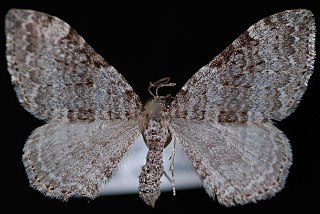
Xanthorhoe macdunnoughi is a species of moth in the family Geometridae. It was described by Louis W. Swett in 1918 and is found in North America, where it has been recorded from open wooded areas in western North America, ranging east to western Alberta and south to California.


















